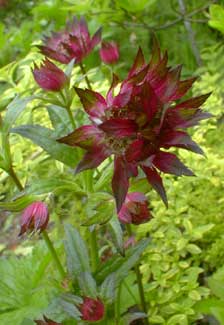
'Ruby Wedding'
Greater Masterwort
"It is simply unbelievable how happy flowers are."
-Vrienden van Osho
(1931-1990)
(1931-1990)
Astrantia major 'Ruby Wedding' is a 1986 introduction originated the garden of a Mrs. Phyllis Barwood in Oxfordshire, England. It was named in honor of her own fortieth or ruby anniversary.
Astrantia is often said to mean "starry" or "like an aster," but is actually a corruption of Ostrotium, or Ostritch-like, because the flowers resemble a an ostrich's feathery tale. "Masterwort" is a name applied to sundry parsley-family herbs several of which are used in herbal medicines.
Cultivated since the 16th Century, masterwort has acquired a few additional folk-names along its history, including Gentleman's Melancholy, Hattie's Pincushion, Mountain Sanicle, & Black-root Sanicle.
The root of Greater Masterwort has been used as a diuretic & for sundry purported health values. It's intriguing that traditional claims for masterwort as an herbal remedy could not be shown factual in controlled studies, yet masterwort saponins have been proven to possess antifungal activity, although wouldn't you know it, its potentially valid use was not ascribed to it by tradition!
'Ruby Wedding' has dark red flowers with apple-green highlights on maroon stems. It is among the reddest of all masterworts. The large palm-shaped leaves have ornamentality even when not flowering.
Our clump was started from seed. The very best reds are preserved clonally, & the seedlings are not guaranteed to bloom as deep a red, but even seed-grown Ruby Reds are invariably a great deal redder than the majority of masterwords.
Masterworts make great cut flowers for fresh bouquets. They also dry well for dried flower arranging. In the garden they have a long bloom season with deadheading. They want full sun to partial shade in moist humusy soil. It rather dislikes droughtiness.